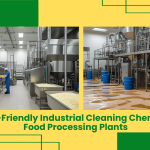Maintaining a healthy office environment involves more than regular tidying. Indoor air quality, surface hygiene, and occupant comfort all connect. Traditional cleaning products may emit volatile organic compounds (VOCs) that linger and affect well-being. Adopting zero-VOC cleaners, including formulations based on organic acid ingredients, addresses these issues without sacrificing performance. Below, explore common office cleaning challenges, how zero-VOC cleaners and organic acid solutions help, preventive measures, and ways Ecochem’s digital signage platform can streamline communication and protocols.
Identifying Office Cleaning Challenges
Poor Indoor Air Quality
- Some cleaning products release VOCs during or after use. Over time, these compounds can build up in enclosed areas.
- Symptoms linked to VOC exposure include headaches, throat irritation, or fatigue among staff.
- Enclosed office layouts or limited ventilation make accumulation more likely, especially after evening or weekend cleaning.
Surface Contamination and High-Touch Areas
- Frequent contact points—door handles, shared equipment, kitchenettes—harbor germs that spread illnesses.
- Harsh disinfectants may clean effectively but leave residues or strong odors, affecting comfort.
- Inconsistent cleaning routines can leave some zones neglected, increasing risk of surface-borne issues.
Regulatory and Sustainability Goals
- Companies often aim to reduce environmental impact; cleaning supplies contribute to an organization’s footprint.
- Regulations or certifications (e.g., green building standards) may favor products without harmful emissions.
- Employees increasingly value workplace wellness and eco-friendly practices.
How Zero-VOC Cleaners and Organic Acid Formulations Help
Switching to cleaners with zero-VOC labels and organic acid–based ingredients balances efficacy and safety. These solutions break down contaminants without contributing to indoor air pollution.
Zero-VOC Advantages
- No Harmful Emissions: By definition, zero-VOC cleaners avoid or eliminate solvents that evaporate into the air, reducing odor and irritation.
- Better Air Quality: zero-VOC cleaners air supports concentration and comfort, helping staff stay alert and productive.
- Compatibility with Ventilation Systems: Without VOCs, HVAC systems face less burden removing airborne chemicals.
- Positive Perception: Occupants notice when cleaning smells are mild; this builds confidence in workplace care.
Role of Organic Acid Ingredients
- Natural Cleaning Action: Organic acids (such as citric acid, lactic acid) dissolve mineral deposits, help break down light soils, and offer mild antimicrobial effects.
- Biodegradability: After use, organic acids break down naturally in wastewater, limiting environmental impact.
- Material Safety: Compared to harsh alkalis or strong solvents, organic acid formulas are gentler on surfaces like stainless steel, glass, or sealed desks.
- Balanced pH: Many organic acid cleaners maintain a slightly acidic profile, effective against certain residues (e.g., coffee stains, hard-water spots) without damaging finishes.
Effective Germ Control without Strong Odors
- Combining zero-VOC solvents with targeted organic acid ingredients can reduce microbial load on surfaces.
- When formulations include safe antimicrobial additives compatible with organic acids, offices benefit from sanitized areas without lingering chemical smells.
- Such cleaners can be used routinely on high-touch surfaces, break areas, and restrooms to limit pathogen spread.
Implementing Zero-VOC and Organic Acid Cleaning
Transitioning to safer products requires planning and clear communication. Here are steps for adopting and maximizing benefits.
Product Selection and Testing
- Trial in a Pilot Zone: Select a low-traffic area or single department to test zero-VOC cleaners with organic acid bases. Observe cleaning ease, residue, odor, and staff feedback.
- Surface Compatibility Check: Confirm the cleaner works on desktops, electronics-safe wipes, glass, and common office flooring without damage.
- Review Safety Data Sheets: Ensure formulations truly list zero or minimal VOC content and identify any precautions.
- Vendor Collaboration: Work with suppliers offering transparent ingredient lists and performance data.
Training and Guidelines
- Clear Instructions: Provide concise dilution ratios and application methods. Use printed cards or digital displays in janitorial closets.
- Demonstrations: Show proper wiping techniques for electronics-friendly sprays, kitchenette surfaces, and restroom fixtures.
- Frequency Schedules: Define routine cleaning intervals for high-touch zones versus periodic deep cleans.
- Personal Protective Equipment: Even with safer cleaners, gloves or eye protection may be recommended; communicate required gear.
Integrating with Ecochem’s Platform
- Task Assignment via Digital Signage: Use Ecochem to broadcast cleaning schedules to maintenance teams. Screens in utility rooms or staff hubs remind workers of next cleaning tasks.
- Instant Alerts for Spill Response: If an employee reports a spill near shared equipment, Ecochem can display an immediate notification to cleaning staff, ensuring quick action.
- Training Content Delivery: Host short videos or infographics on using zero-VOC, organic acid cleaners. Display these on office monitors or kiosks in break areas.
- Feedback Collection: Through polls or brief surveys on digital signage, gather employee input on cleaning effectiveness or lingering concerns.
- Inventory Tracking: Integrate procurement apps to monitor stock of zero-VOC cleaner containers. When levels run low, automated reorder prompts help avoid last-minute shortages.
- Air Quality Monitoring Alerts: If sensors detect poor ventilation or indoor pollutants, Ecochem can suggest increased ventilation or targeted surface cleaning with zero-VOC products to reduce residual irritants.
Prevention Tips to Maintain a Healthy Office
Beyond cleaning products, preventive practices reduce the need for heavy-duty interventions and support well-being.
Ventilation Management
- Regular HVAC Maintenance: Ensure filters are clean and replaced on schedule; good airflow reduces trapping airborne particles.
- Natural Ventilation: When weather and security permit, open windows briefly after cleaning to air out any mild scents.
- Air Purifiers: Consider units with HEPA filters in meeting rooms or areas with limited airflow.
Cleaning Calls For Eco-Green Shine (Toilet Cleaner)
Toilets and Ceramic surfaces are the toughest to upkeep as these areas are considered most unhygienic. Our Ecochem scientists have prepared natural, green herbal and organic chemicals for cleaning to provide best toilet cleaners. The formulation of Eco-Green Shine (toilet cleaner) is prep with an ideal viscosity to fight against tough stains leaving no residue behind. With our mission to offer harmless cleaning chemicals, we ensure that our products are efficient enough to cleanse the surface, leaving it 99.99% microbes free.
Spill and Stain Prevention
- Protective Mats and Coasters: Place mats under coffee machines; use coasters at desks to catch spills before they reach surfaces.
- Prompt Wipe-Ups: Encourage employees to report spills immediately via a simple digital form or messaging channel; prompt cleaning prevents stain setting.
- Supply Accessible Cleaning Wipes: Stock organic acid–based wipes near communal equipment so small messes get addressed quickly.
Routine Surface Care
- Scheduled Light Cleaning: Frequent wipe-downs of keyboards, phones, and door handles using zero-VOC wipes reduce microbial buildup.
- Deep Cleaning Intervals: Plan quarterly or monthly deep cleans of carpets or upholstery, choosing methods compatible with zero-VOC detergents.
- Equipment Maintenance: Keep electronics dust-free; dust can trap pollutants or interfere with ventilation around devices.
Staff Education and Engagement
- Awareness Campaigns: Use digital signage to display tips for desk hygiene, handwashing reminders, or benefits of green cleaning.
- Recognition Programs: Acknowledge teams or individuals who help maintain cleanliness, reinforcing positive habits.
- Green Certifications: If pursuing certifications (e.g., LEED or WELL), document the use of zero-VOC cleaners and prevention efforts as part of application.
Give Floor A Glow With Eco-Green Flo!
Eco-Green Flo is a cleaning solution made with extrinsic research from researchers at Ecochem. With our inclination towards bio-based cleaning products, this natural concentrate has strong abilities to sanitize any type of floors gently and adds a mirror shine to the surfaces. With single usage, the solution cleanses ceramic walls, floor tiles, lacquered surfaces, marble floors, marble surfaces, ceramic walls in minutes.
Measuring Impact and Continuous Improvement
Tracking outcomes helps refine cleaning programs and demonstrate value to stakeholders.
Health and Comfort Metrics
- Employee Feedback Surveys: Periodically ask about perceived air quality, odors, or surface cleanliness.
- Absenteeism Trends: Monitor if improved cleaning correlates with fewer sick days over time.
- Indoor Air Quality Data: If available, track volatile compound readings before and after switching cleaners.
Operational Efficiency
- Time Savings: Record if zero-VOC formulas require less rinsing or dry faster, allowing quicker room reuse.
- Resource Use: Compare water or paper towel consumption before and after product change.
- Cost Analysis: While eco-friendly cleaners may have different price points, factor in long-term benefits like reduced maintenance or health-related costs.
Data-Driven Adjustments via Ecochem
- Dashboard Reporting: Use Ecochem’s platform to centralize cleaning logs, feedback results, and supply levels.
- Trend Identification: Spot areas needing more frequent attention or alternative approaches.
- Automated Reminders: Adjust notification frequency based on past compliance rates or emerging needs.
- Integration with Other Systems: Link with facility management software to coordinate cleaning with maintenance tasks (e.g., carpet cleaning when HVAC filter changes).
Key Takeaways
- Offices face air quality and surface hygiene challenges; VOC-free, organic acid–based cleaners reduce risks without strong odors.
- Testing products, training staff, and clear guidelines ensure a smooth shift to zero-VOC cleaning.
- Preventive measures—ventilation care, prompt spill response, and routine wipe-downs—limit heavy cleaning demands.
- Ecochem’s digital signage platform supports task scheduling, alerts, training delivery, and data tracking to keep protocols visible and efficient.
- Regular measurement of health, resource, and operational metrics informs continuous improvement, aligning cleaning efforts with sustainability and well-being goals.
Adopting zero-VOC cleaners with organic acid ingredients helps offices maintain a healthier environment. Paired with Ecochem’s integrated communication and management tools, facilities can ensure consistent practices, clear guidance, and ongoing monitoring—benefiting both occupants and organizational objectives.
FAQ‘S
What are zero-VOC cleaners?
Zero-VOC cleaners use ingredients that emit minimal volatile organic compounds, improving indoor air quality and user comfort naturally every day.
How do organic acid cleaners work?
Organic acid cleaners use natural acids like citric or lactic acid to dissolve mineral deposits, remove stains and sanitize surfaces.
Are zero-VOC cleaners effective against germs?
In zero-VOC cleaners, many formulations combine organic acid or safe antimicrobial additives, providing effective germ reduction without strong chemical odors or residues daily.
How often should offices use zero-VOC cleaners?
Schedule routine cleaning weekly for high-touch areas, adjust frequency based on usage patterns and air quality observations, and regularly ensure health.
How to integrate cleaning protocols with Ecochem?
Use Ecochem signage to broadcast schedules, post application guidelines, collect feedback, and monitor supply levels seamlessly, improving operational efficiency consistently.
Written By: Vinny Jain


